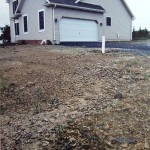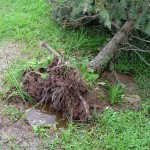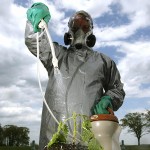Top 10 Landscape Foul-ups to Avoid

This is what often lurks just a few topsoil inches below many yards.
1.) Not improving lousy soil. So many of us have heavily graded subsoil, heavy clay or rock-hard shale — or all three. Work 2 or 3 inches of compost into the top foot of your existing “soil” to make slightly raised and well drained planting beds. Otherwise, you might as well plant in the driveway.
2.) Planting too closely. Find out the mature widths of your plants and plant accordingly, not by how they look now. Much of the pruning we do is shearing (more like butchering) to keep everything from growing into one another.
3.) Dwarfing the house. Don’t plant hulking monsters around the foundation where they’ll block the windows and swallow the front door. Again, think about mature sizes when choosing.
4.) Wrong plant, wrong place. You can’t plant anything wherever you feel like it. Plants aren’t like furniture. They’re living organisms with specific needs — some more particular than others. Know the planting site (sun? shade? wet? dry?) and choose plants that match those conditions.

No wonder roots rot when saturated soil surrounds them.
5.) Rotting roots. Very few plants tolerate soggy soil. Pay attention to where water is coming from and going to on your property and then avoid planting where water pools. Or correct drainage problems. Much of this mayhem relates back to the poorly drained subsoil and clay you’re probably starting with.
6.) Planting too deeply. Find the point at the base of a tree or shrub where the trunk flares out and plant that point just above grade. Any deeper and you risk rotting the bark and smothering the roots. Many trees in particular are already planted too deeply in their pots and burlap bags, so just planting at the same depth doesn’t guarantee correct depth. Planting deeper to “keep the plant from blowing over” also is a bad-news myth.
7.) Too-skinny beds and sidewalks. Get bold. Make those foundation beds wide, and make your walks big enough for two people to walk side-by-side (4 to 5 feet). Why do we put walks 3 feet from the house when we often have 50 feet or more for a front yard? More space gives you more options and cuts down on the size-control pruning that skinny beds require.
8.) Overdoing it with fertilizer. More isn’t better. Besides, most plant problems are related to things other than soil nutrition anyway. Occasional soil tests are a good idea to determine what kind of fertilizer you ought to use and exactly how much — if any. Over-fertilizing causes water pollution and can even harm plant growth, not to mention waste time and money.

Spraying everything at the first sign of something crawling is not a great idea.
9.) Spraying “just in case.” Also a major polluter and waste of money that can do more harm than good. Figure out the problem first and then target the action – if any is even needed. Many bug problems are temporary and cosmetic. And killing off beneficial insects that control pest bugs by spraying all the time can actually be counter-productive.
10.) Pruning miscues. Different plants need different types of pruning. Learn the when’s and how’s of each so you don’t destroy the habit, cut off flower buds or just give up and end up with an overgrown blob. Particularly harmful is the practice of “topping” or indiscriminately shearing trees. This can lead to disease and weak branch attachments that can then lead to tree failure. There’s a big difference between pruning and butchering.







